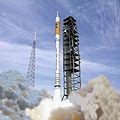Датотека:Aiaa2.jpg

Величина овог приказа: 600 × 600 пиксела. 2 друге резолуције: 240 × 240 пиксела | 639 × 639 пиксела.
Оригинална датотека (639 × 639 пиксела, величина датотеке: 84 kB, MIME тип: image/jpeg)
Историја датотеке
Кликните на датум/време да бисте видели тадашњу верзију датотеке.
| Датум/време | Минијатура | Димензије | Корисник | Коментар | |
|---|---|---|---|---|---|
| тренутна | 17:18, 3. новембар 2008. |  | 639 × 639 (84 kB) | Aaaf-wiki~commonswiki | {{Information |Description={{en|1=JSC2008e039697, 2008 - The Ares I Crew Launch Vehicle is being developed at Marshall Space Flight Center in Huntsville, Alabama, and is a two-stage vehicle designed solely for carrying the Orion CEV to Earth orbit. The 9 |
Употреба датотеке
Следећа страница користи ову датотеку:
Глобална употреба датотеке
Други викији који користе ову датотеку:
- Употреба на ar.wikipedia.org
- Употреба на de.wikipedia.org
- Употреба на en.wikipedia.org
- Употреба на he.wikipedia.org
- Употреба на hr.wikipedia.org
- Употреба на nl.wikipedia.org
- Употреба на nl.wikinews.org
- Употреба на no.wikipedia.org
- Употреба на ru.wikipedia.org
- Употреба на tr.wikipedia.org

